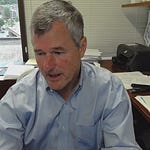Michael Clarke, Environmental Manager at The Metals Company, brings over 30 years of conservation biology experience to impact assessment of potential mining in the CCZ. Mike explains the details of how TMC goes about conducting one of the largest-ever marine environmental baseline programs, the challenges of gathering and interpreting deep-sea data, and the critical trade-offs between land-based and ocean resource extraction.
From sediment plumes to carbon concerns, Mike breaks down what the data shows—and what it doesn’t—when it comes to the potential environmental impact of deep-sea mining. If you’re trying to understand the nuances of deep-sea mining’s environmental footprint, and how these decisions balance against terrestrial mining pressures, this episode is a must-listen.
Shortly after this was recorded The Metals Company made the first ever submission for a commercial recovery permit in international waters under U.S. law. Details can be found on their website: https://investors.metals.co/news-releases/news-release-details/world-first-tmc-usa-submits-application-commercial-recovery-deep.
Topics Covered:
Michael’s global conservation background and path to DSM
TMC’s $250M environmental baseline study
Noise, light, sedimentation, and carbon impacts: findings and misconceptions
Technical challenges of offshore environmental science
The trade-offs between deep-sea and Indonesian rainforest nickel mining
How science feeds into decision-making for sustainability
Why polarized narratives around deep-sea mining often miss the real questions
Follow Mike on LinkedIn https://www.linkedin.com/in/michael-clarke-6575501b/
Resources Mentioned:
International Seabed Authority Publications https://www.isa.org.jm/publications/
Polymetallic Nodule Research Alliance https://noduleresearch.com/
TMC’s Research web page https://metals.co/research/
SMARTEX study https://www.nature.com/articles/s41586-025-08921-3
⏱️ Timestamps
02:08 — Early career: conservation work, invasive species research, global fieldwork
08:23 — Transition to industrial EIAs and mining projects
09:41 — Joining The Metals Company and focus on deep-sea mining
12:29 — Trade-offs and decision-making in environmental assessments
17:07 — How deep-sea environmental studies are designed and conducted
20:07 — Research logistics: campaigns, challenges, and COVID adaptations
22:36 — Partnering with universities and ensuring independent data publication
27:22 — Key technical challenges in deep-sea sampling and monitoring
34:48 — Findings on noise impacts from mining operations
39:32 — Managing zones of impact and minimizing environmental spread
42:34 — Sediment and midwater plume behavior and impact modeling
58:06 — Understanding cumulative impacts and the role of regulation
1:04:15 — Other impacts: carbon release, lights, and habitat loss
1:06:56 — Protecting biodiversity: mining strategy and protected areas
1:10:40 — Funding environmental research and trust in scientific integrity
1:14:45 — Long-term monitoring plans and Pacific Islander involvement
1:17:50 — Reflections on environmental consulting and early design influence
1:20:38 — Media misrepresentation and public misunderstanding of research
1:24:09 — Trade-offs: deep-sea mining versus rainforest destruction
1:29:03 — Closing thoughts, resources, and where to learn more
Theme music Tamarack by Jesse Matas












Share this post